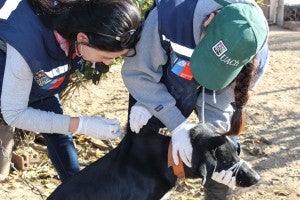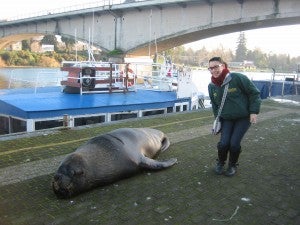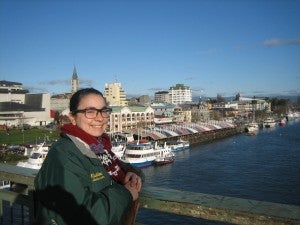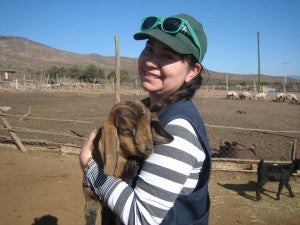Contributed by Marlene Belmar, Class of 2018
Photos courtesy of Dr. Gerardo Acosta
My life long career goal within veterinary medicine is to specialize in epidemiology and apply my knowledge and skills towards a better understanding of zoonotic diseases. This past summer, I had a wonderful opportunity to go to Chile to participate in a research project entitled “Control and Prevention of Hydatidosis/Echinococcosis in the communes of Punitaqui, Monte Patria and Combarbalá within the province of Limarí in the region of Coquimbo,” under the mentorship of Dr. Gerardo Acosta-Jamett.
Hydatidosis is a zoonotic disease of high public health concern within Chile, where dogs are the intermediate host and herbivores and humans are the definitive host. Studies evaluating risk factors associated with the presence of E. granulosus in dog feces have only been initiated recently. Having the opportunity to participate in a project that is striving to improve the lives of people and animals in underserved areas of Chile sparked all of my interests.
 The first stop on this adventure was the northern city of Ovalle where I was welcomed with open arms by a team of three veterinarians and three technicians. Upon arrival, I joined the rest of the team in their first meeting with members of the Regional Government of Coquimbo where I had the opportunity to learn more about the project. During the three weeks that I was in Ovalle, each day we would get up very early in the morning, pack up our jeeps with all the material we would need for the day and head to one of the three poor rural communes where people’s main source of income are sheep and goats, many affected with Hydatidosis.
The first stop on this adventure was the northern city of Ovalle where I was welcomed with open arms by a team of three veterinarians and three technicians. Upon arrival, I joined the rest of the team in their first meeting with members of the Regional Government of Coquimbo where I had the opportunity to learn more about the project. During the three weeks that I was in Ovalle, each day we would get up very early in the morning, pack up our jeeps with all the material we would need for the day and head to one of the three poor rural communes where people’s main source of income are sheep and goats, many affected with Hydatidosis.
At each commune we visited, we would go house to house educating the community about efficient animal care and management practices that will maintain high standards of human and animal health, especially pertaining to preventative practices against Hydatidosis. Within each house visited we would have the pet owners answer a survey about their day-to-day habits as well as the environmental and nutritional habits of their dogs. We also micro-chipped more than 200 dogs, obtained fecal samples, and collected samples of ticks and fleas.
With incidences at a rise, this investigation sought to meet two objectives: (i) reduce the risk of transmission of hydatidosis within canine and human populations by administering oral anti-parasitic medication to canines to interrupt the life cycle of E. granulosus and (ii) develop educational sanitation programs for a better quality of life for the communities in Punitaqui, Monte Patria and Combarbalá, within the province of Limarí.
 The last two weeks of my time in Chile were spent in the southern city of Chile called Valdivia, where I worked one on one with Dr. Acosta-Jamett analyzing all the acquired data from my time in Monte Patria, Combarbalá and Punitaqui. All data analysis took place at the Institute of Veterinary Preventative Medicine within the School of Veterinary Medicine at La Universidad Austral de Chile. Dr. Acosta and I would work during the day and then in the afternoons I would go explore some of the beauties of the cities and enjoy delicious sea food caught that morning by local fishermen. During my time in Valdivia I was fortunate enough to visit botanical gardens, national parks, sea ports where I took pictures with sea lions, la Cerveceria Kunsmann, Entrelagos Café, and Isla Teja.
The last two weeks of my time in Chile were spent in the southern city of Chile called Valdivia, where I worked one on one with Dr. Acosta-Jamett analyzing all the acquired data from my time in Monte Patria, Combarbalá and Punitaqui. All data analysis took place at the Institute of Veterinary Preventative Medicine within the School of Veterinary Medicine at La Universidad Austral de Chile. Dr. Acosta and I would work during the day and then in the afternoons I would go explore some of the beauties of the cities and enjoy delicious sea food caught that morning by local fishermen. During my time in Valdivia I was fortunate enough to visit botanical gardens, national parks, sea ports where I took pictures with sea lions, la Cerveceria Kunsmann, Entrelagos Café, and Isla Teja.
 My summer travels met all my expectations and more. I am very grateful for the opportunity to be part of this project that is genuinely striving to make a difference in so many people’s lives. I feel inspired to keep following my passion in public health. Each day I can say that practicing veterinary medicine internationally is what I can see myself doing for the rest of my life. I would like to extend my deepest gratitude to the SVM International Externship Program for making this incredible experience possible.
My summer travels met all my expectations and more. I am very grateful for the opportunity to be part of this project that is genuinely striving to make a difference in so many people’s lives. I feel inspired to keep following my passion in public health. Each day I can say that practicing veterinary medicine internationally is what I can see myself doing for the rest of my life. I would like to extend my deepest gratitude to the SVM International Externship Program for making this incredible experience possible.

